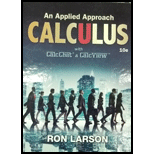
Calculus: An Applied Approach (MindTap Course List)
10th Edition
ISBN: 9781305860919
Author: Ron Larson
Publisher: Cengage Learning
expand_more
expand_more
format_list_bulleted
Concept explainers
Question
Chapter A4, Problem 46E
To determine
To calculate: The zeros of the polynomial (x2+x−20).
Expert Solution & Answer
Want to see the full answer?
Check out a sample textbook solution
Students have asked these similar questions
1. One of the partial fractions for
2
4x²+x-9
x3+2x²-3x
2
x+1
a) x23 b) x 1½ c) x² d)
x-1
x
is
1. One of the partial fractions for
2
2
4x²+x-9
x3+2x²-3x
a) x3 b) x11 c) x² d) z
x-1
2. Identify the improper integral.
1 x
2 x
dx
a) 3x dx b) f² 3x dx
0 3-2x
0 3-2x
x
is
c) √2^:
4
√232x dx d) fo² 3x dx
1 1
0 3-2x
B. So eax dx converges to
if
:
a) O if a0 c) - 1½ ifa 0
Complete the square and find the indefinite integral. (Remember to use absolute values where appropriate. Use C for the
constant of integration.)
dx
x²-12x+27
Chapter A4 Solutions
Calculus: An Applied Approach (MindTap Course List)
Ch. A4 - Prob. 1CPCh. A4 - Prob. 2CPCh. A4 - Prob. 3CPCh. A4 - Prob. 4CPCh. A4 - Prob. 1ECh. A4 - Prob. 2ECh. A4 - Prob. 3ECh. A4 - Prob. 4ECh. A4 - Prob. 5ECh. A4 - Prob. 6E
Ch. A4 - Prob. 7ECh. A4 - Prob. 8ECh. A4 - Prob. 9ECh. A4 - Prob. 10ECh. A4 - Prob. 11ECh. A4 - Prob. 12ECh. A4 - Prob. 13ECh. A4 - Prob. 14ECh. A4 - Prob. 15ECh. A4 - Prob. 16ECh. A4 - Factoring Polynomials In Exercises 9-18, write the...Ch. A4 - Prob. 18ECh. A4 - Prob. 19ECh. A4 - Prob. 20ECh. A4 - Prob. 21ECh. A4 - Prob. 22ECh. A4 - Prob. 23ECh. A4 - Prob. 24ECh. A4 - Prob. 25ECh. A4 - Prob. 26ECh. A4 - Prob. 27ECh. A4 - Prob. 28ECh. A4 - Prob. 29ECh. A4 - Prob. 30ECh. A4 - Prob. 31ECh. A4 - Prob. 32ECh. A4 - Prob. 33ECh. A4 - Prob. 34ECh. A4 - Prob. 35ECh. A4 - Prob. 36ECh. A4 - Prob. 37ECh. A4 - Prob. 38ECh. A4 - Prob. 39ECh. A4 - Prob. 40ECh. A4 - Prob. 41ECh. A4 - Prob. 42ECh. A4 - Prob. 43ECh. A4 - Prob. 44ECh. A4 - Prob. 45ECh. A4 - Prob. 46ECh. A4 - Prob. 47ECh. A4 - Prob. 48ECh. A4 - Prob. 49ECh. A4 - Prob. 50ECh. A4 - Prob. 51ECh. A4 - Prob. 52ECh. A4 - Prob. 53ECh. A4 - Prob. 54ECh. A4 - Prob. 55ECh. A4 - Prob. 56ECh. A4 - Prob. 57ECh. A4 - Prob. 58ECh. A4 - Prob. 59ECh. A4 - Prob. 60ECh. A4 - Prob. 61ECh. A4 - Prob. 62ECh. A4 - Prob. 63ECh. A4 - Prob. 64ECh. A4 - Prob. 65ECh. A4 - Prob. 66ECh. A4 - Prob. 67ECh. A4 - Prob. 68ECh. A4 - Prob. 69ECh. A4 - Prob. 70ECh. A4 - Prob. 71ECh. A4 - Prob. 72ECh. A4 - Prob. 73ECh. A4 - Prob. 74ECh. A4 - Prob. 75ECh. A4 - Prob. 76E
Knowledge Booster
Learn more about
Need a deep-dive on the concept behind this application? Look no further. Learn more about this topic, calculus and related others by exploring similar questions and additional content below.Similar questions
- Complete the table. Enter DNE if a quantity doesn't exist or NEI if not enough information is given. f(c) limx-->c- f(x) limx-->c+ f(x) limx -->c f(x) continuity at x=c 2 4arrow_forwardFind the indefinite integral. (Use C for the constant of integration.) 9x arcsin(x) dxarrow_forwardFind the indefinite integral using the substitution x = 5 sin(e). (Use C for the constant of integration.) 1 dx (25-x²)3/2arrow_forward
- Find the indefinite integral using the substitution x = 7 sec(0). (Use C for the constant of integration.) √ ׳ √x² - 49 dxarrow_forward2 Graph of h 6. The graph of the function h is given in the xy-plane. Which of the following statements is correct? , the graph of h is increasing at an increasing rate. (A) For (B) For (C) For 苏|4 K|4 π π , the graph of h is increasing at a decreasing rate. 2 0 and b>1 (B) a>0 and 01 (D) a<0 and 0arrow_forward3. Consider the sequences of functions fn: [-T, π] → R, sin(n²x) n(2) n (i) Find a function f : [-T, π] R such that fnf pointwise as n∞. Further, show that f uniformly on [-T,π] as n→ ∞. [20 Marks] (ii) Does the sequence of derivatives f(x) has a pointwise limit on [-7,π]? Justify your answer. [10 Marks]arrow_forward
- Good Day, Please assist with the following. Regards,arrow_forwardFor each given function f(x) find f'(x) using the rules learned in section 9.5. 1. f(x)=x32 32x 2. f(x)=7x+13 3. f(x) = x4 4. f(x) = √√x³ 5. f(x) = 3x²+ 3 x2arrow_forwardFind: lim x →-6 f (x) limx-4 f (x) lim x-1 f (x) lim x →4 f (x) (-6,3) • (-1,5) -8 -7 (-6,-2) 4+ (4,5) (4,2) • (-1,1) -6arrow_forward
arrow_back_ios
SEE MORE QUESTIONS
arrow_forward_ios
Recommended textbooks for you
 Big Ideas Math A Bridge To Success Algebra 1: Stu...AlgebraISBN:9781680331141Author:HOUGHTON MIFFLIN HARCOURTPublisher:Houghton Mifflin Harcourt
Big Ideas Math A Bridge To Success Algebra 1: Stu...AlgebraISBN:9781680331141Author:HOUGHTON MIFFLIN HARCOURTPublisher:Houghton Mifflin Harcourt
 College Algebra (MindTap Course List)AlgebraISBN:9781305652231Author:R. David Gustafson, Jeff HughesPublisher:Cengage Learning
College Algebra (MindTap Course List)AlgebraISBN:9781305652231Author:R. David Gustafson, Jeff HughesPublisher:Cengage Learning

Big Ideas Math A Bridge To Success Algebra 1: Stu...
Algebra
ISBN:9781680331141
Author:HOUGHTON MIFFLIN HARCOURT
Publisher:Houghton Mifflin Harcourt


College Algebra (MindTap Course List)
Algebra
ISBN:9781305652231
Author:R. David Gustafson, Jeff Hughes
Publisher:Cengage Learning

Polynomials with Trigonometric Solutions (2 of 3: Substitute & solve); Author: Eddie Woo;https://www.youtube.com/watch?v=EnfhYp4o20w;License: Standard YouTube License, CC-BY
Quick Revision of Polynomials | Tricks to Solve Polynomials in Algebra | Maths Tricks | Letstute; Author: Let'stute;https://www.youtube.com/watch?v=YmDnGcol-gs;License: Standard YouTube License, CC-BY
Introduction to Polynomials; Author: Professor Dave Explains;https://www.youtube.com/watch?v=nPPNgin7W7Y;License: Standard Youtube License